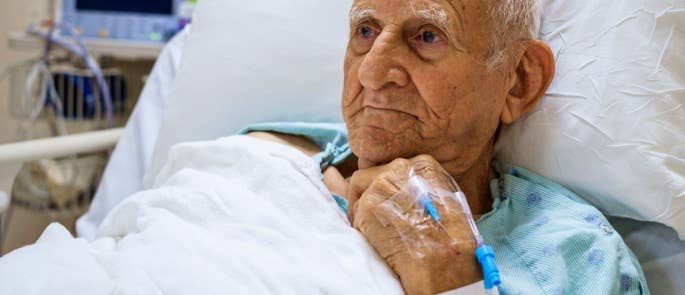What is the Hospital Discharge Process?
When a patient is due to leave the hospital, they will go through a discharge process. Understanding this process is important for both patients and their caregivers, and provides them with all the relevant information required for their continued care and treatment. We will explain more about who and what is involved in this process throughout this article.
We will also look at the importance of good communication throughout the discharge process, offer advice on how to provide support to those leaving hospital, and discuss the various types of discharge that can occur. Whether you have been through the process yourself or you are supporting someone through the process personally or professionally, this article aims to offer insights and summarise the various components of hospital discharge.
What is the Hospital Discharge Process?
The hospital discharge process is what happens when a patient no longer needs care and treatment as an inpatient at the hospital and can leave to either go home or on to an appropriate care facility, e.g. a care home or a hospice. Being discharged from hospital does not necessarily mean that the patient is fully recovered or well, rather that it is now more appropriate for them to continue their recovery or receive continued care and treatment elsewhere.
This can involve anything from rest and recuperation at home with minimal assistance, visits from community health and social care teams, transfer to a rehabilitation unit, or continued regular visits to the hospital as an outpatient. The options for how people are cared for, treated and supported post discharge depends on their circumstances.
When it comes to a patient’s discharge, proper planning is a vital part of continuity in care. During the planning process, the care team within the hospital will consider what support the patient will require after they leave, this process will involve the patient themselves and their family or carer where appropriate. If they require community services, it must be planned before discharge to ensure there is no lapse in care and support being received between leaving hospital and their community care beginning.
If ongoing support in the community is required (also known as complex discharge), the hospital will liaise with the appropriate services to manage the patient’s discharge effectively. This may include arranging where the patient will stay after leaving the hospital, transport home, arranging community services such as district nurses or domiciliary care, or ensuring the patient has access to specialised equipment, such as a hospital-type bed, hoists, pressure relieving aids, or mobility equipment.
Information regarding the patient must be handed over from the hospital to the relevant community teams to ensure the most appropriate and informed care plan can be put in place for the patient. Without adequate planning and communication during the discharge process, there can be a delay in the patient leaving the hospital. This takes up valuable inpatient bed space within the hospital and can lead to poorer patient outcomes.

It may be the case that minimal or no community services are required after discharge (also known as minimal discharge) and the patient will either self-care or receive support from family and friends. This is often the case with those who are generally fit and well and are perhaps recovering from a temporary illness, injury or surgery.
Whatever the reason, if care is to be provided by an unpaid carer such as a family member, the discharge process will still involve the hospital team ensuring a discharge plan is created. This is to make sure both patient and carer have all the resources and information they need for a successful outcome.
What is the NHS Hospital Discharge Policy?
To ensure the process runs effectively, policies are put in place, with each hospital having its own discharge policy. A copy of which can be obtained, either via the manager of the ward the patient has been admitted to, or The Patient Advice and Liaison Service (PALS), the service which acts as a point of contact for patients and their families or carers.
Whilst each hospital has their own policies, they should all be aiming to achieve:
- A discharge process that delivers a high-quality care experience for all patients and their families and/or carers.
- The full involvement of the patient and, where appropriate, their family and/or carer throughout each stage of the process.
- Good communication, ensuring the patient knows what to expect when they leave and that they have the relevant information regarding any continuing care or treatment they require, including contact information for those services.
- An expected date of discharge (EDD) should be provided, keeping the patient informed of any changes along the way so they can plan appropriately.
- Full understanding of role and responsibilities relating to the discharge planning process from all professional parties involved.
- Clearly documented discharge planning, with all relevant protocols being followed.
- Implementation of risk assessment processes that are integral to the planning of care assessments.
- Effective communication between multi-disciplinary and community-based services.
Following policies and procedures helps to make sure all patients are discharged safely from hospital. It also ensures they are in the most appropriate place for them and their circumstances, and that they have access to the care and support they need. Avoiding prolonged stays in hospital and keeping the patient involved in the decision making process, all helps to ensure they are being provided with dignity in care.

Why is it Important to Communicate Discharge Instructions to Patients?
Communication is important in all areas of life, but particularly so within the health and social care sector. Hospitals have a diverse mix of patients, each having their individual communication needs. This can be due to a sensory impairment, language barrier, cognitive impairment, learning disability, their age, or due to the implications of their current state of health.
Ensuring the patient and their family and/or carer fully understand all aspects of the discharge process, such as what to expect next and what is expected of them, is incredibly important. There can be a lot of information to share and it can feel overwhelming for those involved. Where possible the details should be kept simple, concise and avoid overly complex medical terms and acronyms that are not universally understood.
There may be important instructions to communicate relating to the patient’s after care, such as how and when dressings should be changed, how to avoid getting a wound wet, avoiding lifting heavy items, or following a new medication regime etc. Having written records of all the information they require and the contact details of any additional support and care services they will be receiving, needs to be given in a format the patient and their family and/or carer understand.
Communicating discharge instructions to patients encourages their active participation in their own care, and gives them the opportunity to ask questions, clarify any information they are unsure of and helps them and their family and/or carer to prepare for their return home or their transfer elsewhere.
Want to Learn More?
Why not further your learning with our Communication Skills in Health and Social Care or Care Certificate training courses?
How Might Carers Provide Support on Leaving Hospital?
Following hospital discharge, people may need support in a variety of ways; this could be physical or emotional or both. Depending on the support required, it may be provided in person or from a distance, such as via telephone or video calls. If the patient requires care and support with their daily living tasks when they leave hospital, that support may include:
- Helping with housework: cooking, cleaning, laundry, and emptying bins etc.
- Assisting with personal care: washing, showering, getting dressed, and shaving etc.
- Helping with errands: shopping, collecting medications, and getting to appointments.
- Assisting with their mobility or altered capabilities: helping them to move around, access things they can’t reach, and helping with tasks they struggle with. For example someone with a broken arm may struggle to open jars or lift larger items etc.
- Offering emotional support: being patient and empathetic, helping them manage any mental health conditions and helping them to access any support they may need.
- Helping them to manage their finances: ensuring they are managing to pay their bills, such as house payments, utilities and any paid care costs.
The support required for the patient will be decided by a needs assessment and the hospital should ensure they are going to be adequately supported before they are discharged. In cases where minimal care is required, consider helping out by making sure they have everything they need when they return home, such as having enough food in.
If the care is going to be provided by a family member, they can ask for a carer’s assessment for themselves. This assessment is aimed at looking at what help may make life easier for the carer, such as someone taking over the care duties whilst they have a break or receiving training for safe moving and handling practices.

Discharging Elderly Patients from Hospital
When the elderly are discharged from hospital many will need ongoing care and support. For some, it could be the case that a discussion around end of life care planning has taken place. This may mean that when they leave hospital they have additional paperwork in place, such as Do Not Attempt Cardiopulmonary Resuscitation (DNACPR), Advance Decision to Refuse Treatment (ADRT), or Recommended Summary Plan for Emergency Care and Treatment (ReSPECT) documents.
These additional measures are not limited to the elderly, but are often adopted by them. This is because old age can bring an increased likelihood of needing additional and ongoing care and support, which can be down to numerous medical conditions, fragility, reduced mobility, memory problems, and the need to take multiple medications. Therefore, discharges involving the elderly are more likely to require social care involvement and communication between hospital and community teams.
Self-Discharge from Hospital
Patients frequently seek to self-discharge from the hospital. There are many reasons for this, such as feeling uncomfortable in the hospital environment, feeling they are receiving poor care, substance abuse, or feeling the discharge process is taking too long. Unless there are more complex circumstances involving detention under the Mental Health Act, adults with the mental capacity to make the decision have the right to discharge themselves from hospital at any time.
The patient’s doctor should be contacted to explain any risks involved in discharging themselves prematurely, the doctor should prescribe any medications if safe to do so and try to arrange a follow up consultation with the patient if possible. Staff should make sure the appropriate documentation is completed relating to the discharge, ensuring robust and accurate notes are made, particularly if the patient refuses to complete a self-discharge declaration. The patient’s GP and any other relevant services should be notified.
Unsafe Discharge from Hospital
We have discussed the appropriate course of action to ensure patient safety is prioritised during the hospital discharge process, unfortunately there are instances where a patient’s discharge is unsafe. This often comes down to issues such as poor communication between services and between the hospital and the patient’s family and/or carer, and inadequate or no assessment taking place prior to discharge.
Examples of issues faced by patients include:
- Being discharged before they are clinically ready to leave.
- Not being assessed or properly consulted before discharge.
- Their family and/or carer not being informed that they’ve been discharged.
- Being discharged with no care arranged.
- Being kept in hospital longer than necessary due to delays in arranging appropriate care post discharge.
Hospital staff have a duty of care and a responsibility to safeguard adults in their care, keeping them safe and free from harm. Unsafe discharges can leave people in a very unsafe position and puts them at risk in numerous ways. It is most often the case that unsafe discharges lead to re-admissions as their care and support needs have not been sufficiently addressed. Discharging someone in this way can have a negative impact on their wellbeing, independence, dignity and their human rights.

Creating a Hospital Discharge Care Plan
When leaving the hospital there can be lots of information to take away. The hospital may provide a discharge summary that details the admission, any diagnosis and treatment provided, any after-care required and medication details, often discharging the patient with a week’s supply of medication.
A letter will be sent to the patient’s GP (a copy may be provided to the patient), the hospital will also provide details of any ongoing care arrangements and the relevant contact details for those services. The patient and their family and/or carer should leave the hospital knowing what to expect when they get home.
If required, hospital staff will liaise with social services to arrange a discharge assessment. This determines what help is required at home and the assessment may happen in hospital, or they might visit the patient’s home to see if any equipment is required and if the living arrangements are appropriate.
The patient and their family and/or carer should be involved throughout this process and it is advised they speak to staff in charge of the discharge to make sure everything is in place, including a discharge date, care plan and equipment if required.
A discharge care plan should include details, such as:
- The treatment and support that will be provided.
- Who will provide the support along with their contact details.
- How often support will be provided.
- The monitoring and review process for support.
- Details of the person coordinating the care plan.
- Who to contact in an emergency or if there are any issues post discharge.
- Details of any care costs to be paid (if applicable).
Throughout the discharge process, clear communication is required between all parties and services involved. The safety, wellbeing and dignity of the patient should be a priority at all times and the patient and those caring for them should leave the hospital knowing exactly what to expect, what is expected of them and have access to the support and resources they require.
Further Resources:
- Dignity in Care Training Course
- Medication Training for Care
- End of Life Planning in Health and Social Care Article
- What is Reablement?
- What is the Care Certificate & Why is it Important?







